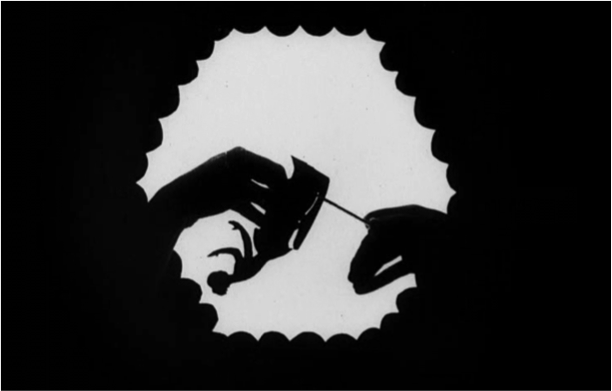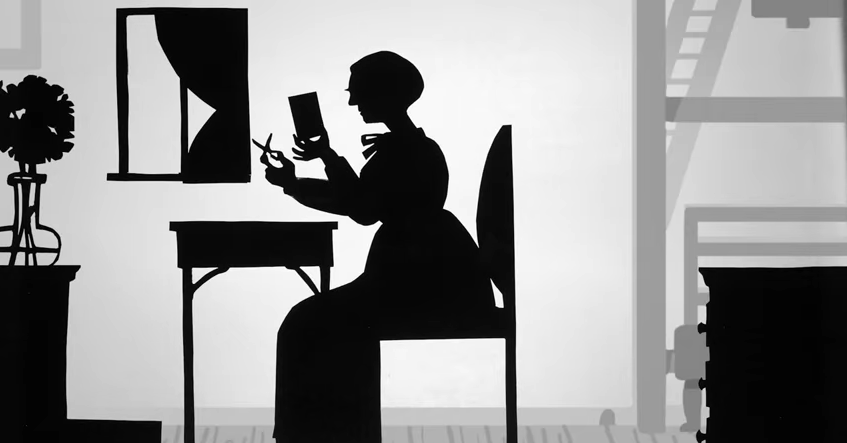In the seminal study of Weimar cinema, From Caligari to Hitler: A Psychological History of German film (1947), Siegfried Kracauer offers an intriguing tribute to Lotte Reiniger, the pioneering filmmaker best known today for directing the earliest surviving animated feature, The Adventure’s of Prince Achmed (1926): ‘In a tiny realm of her own, Lotte Reiniger swung her scissors diligently, preparing one sweet silhouette film after another’ (Kracauer, 2004: 128).
While Reiniger’s inclusion is significant – the animator is documented alongside Fritz Lang, G. W. Pabst and many other celebrated figures from the period – Kracauer’s comment has proved problematic for scholars attempting to rediscover this largely forgotten woman filmmaker. Rachel Palfreyman (2011: 6), for example, interprets the remark as ‘a gendered dismissal of [Reiniger’s] work as merely craft rather than art’. Feminists, art-historians and curators have highlighted the historical tendency to disregard handicraft or decorative works, stemming from an age-old hierarchy of ‘high’ versus ‘low’ art that devalues such ‘women’s work’ specifically because it was associated with the domestic and the ‘feminine’.[1] In effect, whilst segregating Reiniger from the other (almost entirely male) filmmakers catalogued in the volume, Kracauer’s ‘tiny realm’ image is patronizing, representing a marginalized ‘domestic’ space occupied by Reiniger and her ‘sweet’ handcrafted films.
However, there are myriad connections between Reiniger’s silhouette filmmaking technique and traditional handicraft. While her animation practice is rooted in silhouette portraiture, paper-cutting and Eastern shadow play traditions, the self-taught animator enjoyed a long career in independent filmmaking often working from a simple home-studio. Employing basic materials such as scissors, card and wire, Reiniger’s handmade characters and backdrops were animated on the Tricktisch, an animation table designed with her husband. In Reiniger’s silhouette shorts Cinderella (1922) and The King’s Breakfast (1937), the animator’s hands quite literally enter the frame to construct their protagonists.
Animation scholar William Moritz (2009: 15) suggests: ‘The genre of silhouette films also constitutes for Reiniger a kind of feminist validation of a women’s folk art form’. Through her pioneering fusion of silhouette craft with the emerging medium of animation film, Reiniger’s work transforms a handmade form – traditionally practiced by women with no access to formal training – into a distinctly modern and aesthetically radical medium. It is the very handcrafted and homemade quality of Reiniger’s animations that renders her films so powerful. Her creative practice specifically flourishes within a ‘domestic’ environment, rather than being inhibited by these conditions. In a 2015 ‘Female Gaze’ edition of Sight and Sound, the contemporary animator Ruth Lingford reflects on Reiniger as one of her ‘formidable female role-models’ in the 1980s, recalling that ‘animation seemed like a female-friendly art form, with its craft associations and its cottage-industry promise of self-sufficiency’(Lingford, 2015). Today, thanks to the rise of the Internet (particularly social media and the proliferation of video hosting websites), Reiniger’s silhouette films are being received by a whole new audience base. Her preference for small-scale filmmaking and independence are often championed in recent publicity, such as the commemorative ‘Google Doodle’ film in 2016 which opens with a silhouette Reiniger in her typical, homely production context.
Throughout her long career from 1919 to 1980, Reiniger was keen to share techniques and encourage a ‘Do-It-Yourself’ approach to silhouette filmmaking. Publishing a multitude of ‘How-To’ guides in magazines and journals – as well as her own book on Shadow Theatres and Shadow Films (1970) – the documentary The Art of Lotte Reiniger (1970, by John Isaacs) captures the animator in her seventies explaining to her audience:
This is the trick table. If you don’t have such a thing at home, you take your best dining table, cut a hole into it, put a glass plate over it, and over the glass plate some transparent paper.
Reiniger’s instructions here are wonderfully subversive, a display of characteristic wit loaded with a strong, feminist message. Just as her contemporary Hannah Höch reclaims the kitchen knife in the seminal photomontage, Cut with the Kitchen Knife Dada Through the Last Weimar Beer-Belly Cultural Epoch of Germany, 1919-1920, Reiniger calls on others to reclaim the dining table, literally cutting through this symbol of domesticity to make space for innovation and autonomy. Returning to Siegfried Kracauer’s comment, by framing Reiniger as an artisan, his ‘tiny realm’ becomes an accurate allusion to her usual production setting, whether her home-studio Tricktisch or the tiny garden shed in Potsdam where Reiniger and her team produced Prince Achmed between 1923 and 1926. Echoing Virginia Woolf’s powerful treatise on creativity and independence in A Room of One’s Own (1929), Kracauer’s image of Reiniger ‘in a tiny realm of her own’ thus becomes an apt acknowledgement of this unusual yet highly important filmmaker.
References
Kracauer, S. (1947) From Caligari to Hitler: A Psychological History of the German Film. Rev. and exp. ed./edited and introduced by Leonardo Quaresima, Princeton, N.J.; Oxford: Princeton University Press, 2004.
Lingford, R. (2015) ‘The Female Gaze: 100 Overlooked Films Directed by Women’, Sight and Sound, pp. 20-22.
Moritz, W. (2009) ‘Some Critical Perspectives on Lotte Reiniger’, in Margaret Furniss (ed.) Animation, Art and Industry, Eastleigh: John Libbey, pp. 13-19.
Palfreyman, R. (2011) ‘Life and Death in the Shadows: Lotte Reiniger’s Die Abenteuer Des Prinzen Achmed‘, German Life and Letters 64, pp. 6-18.
Tashi Petter is a doctoral candidate in the department of Film Studies, Queen Mary University of London. Her thesis explores the German animator Lotte Reiniger with a focus on Reiniger’s interwar films, her time as an émigré in London and her engagement with folk modernism. Her wider research interests include interwar advertising film, twentieth-century women artists and literary modernisms. She has recently curated screenings of Reiniger’s lesser-known shorts in London.
[1] Maura Reilly, ‘The Dinner party: Curator ’S Overview’, (2007) <https://www.brooklynmuseum.org/eascfa/dinner_party/curatorial_overview>



As a student in the 70s I attended a workshop given by Ms Reiniger’s Canadian producers in Michigan. She was too fragile to attend.They taught us her technique and I went on to work on a film using her technique including her special joint construction and use of rolled lead. What I find missing in this article that saddens me is that Lotte invented many ways of doing this stop motion technique such as how to create depth by using the first multilane camera(years before Disney), how to create the illusion of puppets moving in perspective (citing smaller and smaller versions of the the puppet so they recede into the distance. But trying to pin her choice of silhouettes to some sort of domestic arts is very irritating. In her youth she saw the puppets from Thailand and Burma as Asian arts were all the rage and she not only combined the art form of the silhouette to these puppets but also visualized how she could make them come to life with motion for film. She included many amazing artists among her acquaintances and they became part of her stable such as Walter Ruttmann, Berthold Bartosch, and Carl Koch. Together they came up with new and creative ways to put special effects into her feature such as manipulating sand on glass. Lastly I want to say I am glad that she is getting a boost. She was practically forgotten when I first came in contact with her work in the 70s. She was and is a gifted artist and when arrogant jerks like Michel Ocelot pretend they were not influenced by her work it illustrates what is so wrong with our society that treats a gifted artist like Lotte as someone doing “womanly arts”. This is a woman who with the support of her husband and managed to continue making films will moving around Europe during WW2 and the following years of reconstruction and never gave up her vision! She is a hero.
Lovely post 🙂 I remember being so excited when the Google Doodle came out! It’s really heartening to see emerging scholarship on Reiniger.
The Google Doodle was created by the talented Olivia Huynh. She was one of our animation students at the Maryland Institute Colle of Art.
I find the association of every pioneering female artist as some kind of feminist revelation in the face of an oppressive patriarchal society to be far more condescending and reductionist than any supposed gendered dismissal. What is a “feminist validation of a women’s folk art form” even supposed to mean?
I appreciate Reiniger as much as any animation enthusiast, of course, and because of this I would like to be able to read about and discuss female artists such as herself without the discourse being polluted by feminist theory constantly. I do not intend to dismiss the sociocultural factor of art development and appreciation, but I notice that feminist remarks are mostly used to elevate the status of female artists in order to “compensate” for what is often a mere supposition of “gendered dismissal”. It shifts the focus from the individual to the sex.
The worst sentence in this article is probably the following:
“Reiniger’s instructions here are wonderfully subversive, a display of characteristic wit loaded with a strong, feminist message.”
If that is really what you see in an instruction about cutting a hole in a dining table, then I’m sorry I wasted my time typing up this comment.
Dear Bob, I struggle to see how the elevation of an understated artist through the lens of gender inequality is condescending. Would you prefer that the critique remained as it currently is: remembering Reiniger as a delightful arts and crafts enthusiast?
This article takes steps towards the necessary dismantling of Lotte’s dismissive, patriarchal image (yes, patriarchal – get over it). Positive discrimination, which you could argue applies to this type of retrospective criticism, is a necessary evil in cases where a person has been undervalued or discredited by the status quo.
Besides, what’s not subversive about a 1930s woman cutting a hole in their best dining room table? The message is clear as day.
I’m sorry you wasted your time too Bob.
Bob – your inability to understand the irony, cultural symbolism and social implication of cutting a hole in the dining room table speaks to your wider inability to approach the actual arguments of this article. It seems also that you are irritated that Reiniger not only has the potential to be identified as a specifically female artist but that this identification should be a source of power and positivity, an irritation that you should probably assess on your own time.
Whilst you may have the distinct pleasure of not having truly thought about the winding path – strewn with sweet-wrappers and half-eaten cocktail sausages – that you have taken in your life (a path that has lead you to your computer to dismiss the research of someone actively working to bring to light the life, work and times of an artist that so-called enthusiasts may educate themselves with), others do not have that privilege. If you’d given yourself more time to press your sweaty eyeballs to the screen, you may have found a kind of parallel between your own arch dismissal of polluting feminist discourse and the early dismissal of Reiniger by Kracauer that Petter highlights at the beginning of this piece. Apart from your dislike of feminist discourse as getting in the way of some portrait of the artist as a generalised genderless cypher ‘individual’, you don’t anywhere address Petter’s arguments with a rebuttal that goes beyond ‘No.’
Above all – you don’t deserve an unpolluted version of an artist or their work simply because you can’t be bothered to think critically about the aspects of their identity or work which are fundamental to forming an understanding of them and their cultural afterlife.
If you truly are an enthusiast then maybe you should try harder.
Hear hear!